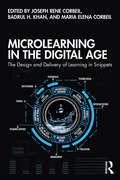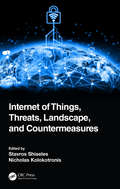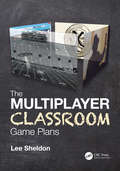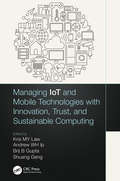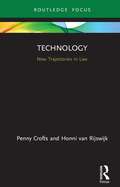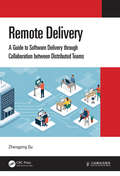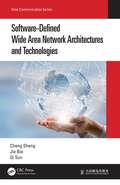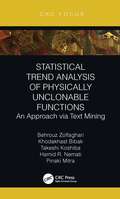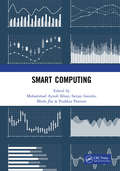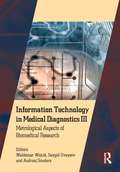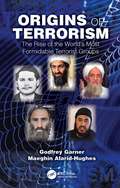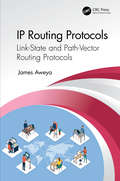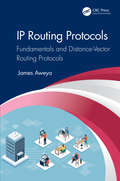- Table View
- List View
Microlearning in the Digital Age: The Design and Delivery of Learning in Snippets
by Joseph-Rene Corbeil Badrul H. Khan Maria Elena CorbeilMicrolearning in the Digital Age explores the design and implementation of bite-sized learning and training in technology-enabled environments. Grounded in research-based best practices and a robust, eight-dimensional framework, this book applies the latest developments in mobile learning, social media, and instructional/multimedia design to one of today’s most innovative and accessible content delivery systems. Featuring experts from higher education, information technology, digital gaming, corporate, and other contexts, this comprehensive guide will prepare graduate students, researchers, and professionals of instructional design, e-learning, and distance education to develop engaging, cost-effective microlearning systems.
Microlearning in the Digital Age: The Design and Delivery of Learning in Snippets
by Joseph Rene CorbeilMicrolearning in the Digital Age explores the design and implementation of bite-sized learning and training in technology-enabled environments. Grounded in research-based best practices and a robust, eight-dimensional framework, this book applies the latest developments in mobile learning, social media, and instructional/multimedia design to one of today’s most innovative and accessible content delivery systems. Featuring experts from higher education, information technology, digital gaming, corporate, and other contexts, this comprehensive guide will prepare graduate students, researchers, and professionals of instructional design, e-learning, and distance education to develop engaging, cost-effective microlearning systems.
Internet of Things, Threats, Landscape, and Countermeasures
by Stavros Shiaeles Nicholas KolokotronisInternet of Things (IoT) is an ecosystem comprised of heterogeneous connected devices that communicate to deliver capabilities making our living, cities, transport, energy, and other areas more intelligent. This book delves into the different cyber-security domains and their challenges due to the massive amount and the heterogeneity of devices. This book introduces readers to the inherent concepts of IoT. It offers case studies showing how IoT counteracts the cyber-security concerns for domains. It provides suggestions on how to mitigate cyber threats by compiling a catalogue of threats that currently comprise the contemporary threat landscape. It then examines different security measures that can be applied to system installations or operational environment and discusses how these measures may alter the threat exploitability level and/or the level of the technical impact. Professionals, graduate students, researchers, academicians, and institutions that are interested in acquiring knowledge in the areas of IoT and cyber-security, will find this book of interest.
Internet of Things, Threats, Landscape, and Countermeasures
by Stavros Shiaeles Nicholas KolokotronisInternet of Things (IoT) is an ecosystem comprised of heterogeneous connected devices that communicate to deliver capabilities making our living, cities, transport, energy, and other areas more intelligent. This book delves into the different cyber-security domains and their challenges due to the massive amount and the heterogeneity of devices. This book introduces readers to the inherent concepts of IoT. It offers case studies showing how IoT counteracts the cyber-security concerns for domains. It provides suggestions on how to mitigate cyber threats by compiling a catalogue of threats that currently comprise the contemporary threat landscape. It then examines different security measures that can be applied to system installations or operational environment and discusses how these measures may alter the threat exploitability level and/or the level of the technical impact. Professionals, graduate students, researchers, academicians, and institutions that are interested in acquiring knowledge in the areas of IoT and cyber-security, will find this book of interest.
The Multiplayer Classroom: Game Plans
by Lee SheldonThe Multiplayer Classroom: Game Plans is a companion to The Multiplayer Classroom: Designing Coursework as a Game, now in its second edition from CRC Press. This book covers four multiplayer classroom projects played in the real world in real time to teach and entertain. They were funded by grants or institutions, collaborations between Lee Sheldon, as writer/designer, and subject matter experts in various fields. They are written to be accessible to anyone--designer, educator, or layperson--interested in game-based learning. The subjects are increasingly relevant in this day and age: physical fitness, Mandarin, cybersecurity, and especially an online class exploring culture and identity on the internet that is unlike any online class you have ever seen. Read the annotated, often-suspenseful stories of how each game, with its unique challenges, thrills, and spills, was built. Lee Sheldon began his writing career in television as a writer-producer, eventually writing more than 200 shows ranging from Charlie’s Angels (writer) to Edge of Night (head writer) to Star Trek: The Next Generation (writer-producer). Having written and designed more than forty commercial and applied video games, Lee spearheaded the first full writing for games concentration in North America at Rensselaer Polytechnic Institute and the second writing concentration at Worcester Polytechnic Institute. He is a regular lecturer and consultant on game design and writing in the United States and abroad. His most recent commercial game, the award-winning The Lion’s Song, is currently on Steam. For the past two years he consulted on an "escape room in a box," funded by NASA, that gives visitors to hundreds of science museums and planetariums the opportunity to play colonizers on the moon. He is currently writing his second mystery novel.
The Multiplayer Classroom: Game Plans
by Lee SheldonThe Multiplayer Classroom: Game Plans is a companion to The Multiplayer Classroom: Designing Coursework as a Game, now in its second edition from CRC Press. This book covers four multiplayer classroom projects played in the real world in real time to teach and entertain. They were funded by grants or institutions, collaborations between Lee Sheldon, as writer/designer, and subject matter experts in various fields. They are written to be accessible to anyone--designer, educator, or layperson--interested in game-based learning. The subjects are increasingly relevant in this day and age: physical fitness, Mandarin, cybersecurity, and especially an online class exploring culture and identity on the internet that is unlike any online class you have ever seen. Read the annotated, often-suspenseful stories of how each game, with its unique challenges, thrills, and spills, was built. Lee Sheldon began his writing career in television as a writer-producer, eventually writing more than 200 shows ranging from Charlie’s Angels (writer) to Edge of Night (head writer) to Star Trek: The Next Generation (writer-producer). Having written and designed more than forty commercial and applied video games, Lee spearheaded the first full writing for games concentration in North America at Rensselaer Polytechnic Institute and the second writing concentration at Worcester Polytechnic Institute. He is a regular lecturer and consultant on game design and writing in the United States and abroad. His most recent commercial game, the award-winning The Lion’s Song, is currently on Steam. For the past two years he consulted on an "escape room in a box," funded by NASA, that gives visitors to hundreds of science museums and planetariums the opportunity to play colonizers on the moon. He is currently writing his second mystery novel.
Managing IoT and Mobile Technologies with Innovation, Trust, and Sustainable Computing
by Kris M. Y. Law Andrew W. H. Ip Brij B. Gupta Shuang GengFocused on the latest mobile technologies, this book addresses specific features (such as IoT) and their adoptions that aim to enable excellence in business in Industry 4.0. Furthermore, this book explores how the adoption of these technologies is related to rising concerns about privacy and trusted communication issues that concern management and leaders of business organizations. Managing IoT and Mobile Technologies with Innovation, Trust, and Sustainable Computing not only targets IT experts and drills down on the technical issues but also provides readers from various groups with a well-linked concept about how the latest trends of mobile technologies are closely related to daily living and the workplace at managerial and even individual levels.
Managing IoT and Mobile Technologies with Innovation, Trust, and Sustainable Computing
by Edited by Kris MY Law, Andrew WH Ip, Brij B Gupta and Shuang GengFocused on the latest mobile technologies, this book addresses specific features (such as IoT) and their adoptions that aim to enable excellence in business in Industry 4.0. Furthermore, this book explores how the adoption of these technologies is related to rising concerns about privacy and trusted communication issues that concern management and leaders of business organizations. Managing IoT and Mobile Technologies with Innovation, Trust, and Sustainable Computing not only targets IT experts and drills down on the technical issues but also provides readers from various groups with a well-linked concept about how the latest trends of mobile technologies are closely related to daily living and the workplace at managerial and even individual levels.
Technology: New Trajectories in Law (New Trajectories in Law)
by Penny Crofts Honni van RijswijkPlacing contemporary technological developments in their historical context, this book argues for the importance of law in their regulation. Technological developments are focused upon overcoming physical and human constraints. There are no normative constraints inherent in the quest for ongoing and future technological development. In contrast, law proffers an essential normative constraint. Just because we can do something, does not mean that we should. Through the application of critical legal theory and jurisprudence to pro-actively engage with technology, this book demonstrates why legal thinking should be prioritised in emerging technological futures. This book articulates classic skills and values such as ethics and justice to ensure that future and ongoing legal engagements with socio-technological developments are tempered by legal normative constraints. Encouraging them to foreground questions of justice and critique when thinking about law and technology, the book addresses law students and teachers, lawyers and critical thinkers concerned with the proliferation of technology in our lives.
Remote Delivery: A Guide to Software Delivery through Collaboration between Distributed Teams
by Zhengping QuThis book records the author’s years of experience in the software industry. In his own practices, the author has found that the distributed work pattern has become increasingly popular in more and more work environments, either between vendors and customers or between different teams inside a company. This means that all practitioners in the software industry need to adapt to this new way of communication and collaboration and get skilled enough to meet the greater challenges in integrating the distributed work pattern with agile software delivery. By centering on the difficulties in communication and collaboration between distributed teams, this book digs into the reasons why so many remote delivery projects end up anticlimactic and provides solutions for readers’ reference. It also cites successful cases in promoting agile development in distributed teams, which has been a vexing problem for many software development companies. In addition, readers can find suggestions and measures for building self-managing teams in this book. Remote Delivery: A Guide to Software Delivery through Collaboration between Distributed Teams is a very practical guide for software delivery teams with their members distributed in different places and companies engaged in software customization. Developers, QAs, product managers, and project leaders can also be inspired by this book.
Remote Delivery: A Guide to Software Delivery through Collaboration between Distributed Teams
by Zhengping QuThis book records the author’s years of experience in the software industry. In his own practices, the author has found that the distributed work pattern has become increasingly popular in more and more work environments, either between vendors and customers or between different teams inside a company. This means that all practitioners in the software industry need to adapt to this new way of communication and collaboration and get skilled enough to meet the greater challenges in integrating the distributed work pattern with agile software delivery. By centering on the difficulties in communication and collaboration between distributed teams, this book digs into the reasons why so many remote delivery projects end up anticlimactic and provides solutions for readers’ reference. It also cites successful cases in promoting agile development in distributed teams, which has been a vexing problem for many software development companies. In addition, readers can find suggestions and measures for building self-managing teams in this book. Remote Delivery: A Guide to Software Delivery through Collaboration between Distributed Teams is a very practical guide for software delivery teams with their members distributed in different places and companies engaged in software customization. Developers, QAs, product managers, and project leaders can also be inspired by this book.
Software-Defined Wide Area Network Architectures and Technologies (Data Communication Series)
by Cheng Sheng Jie Bai Qi SunStarting with problems and challenges faced by enterprise WANs, Software-Defined Wide Area Network Architectures and Technologies provides a detailed description of SD-WAN’s background and basic features, as well as the system architecture, operating mechanism, and application scenarios of the SD-WAN solution based on the implementation of Huawei SD-WAN Solution. It also explains key SD-WAN technologies and analyzes real SD-WAN deployment cases, affording readers with design methods and deployment suggestions for the SD-WAN solution. The information presented in this book is easy to understand and very practical. It enables you to become adept in the SD-WAN solution’s implementation and design principles. The book is intended for ICT practitioners, such as network technical support engineers, network administrators, and network planning engineers, to use in studying theory. Furthermore, it serves as reference material for network technology enthusiasts. Authors Cheng Sheng is the Chief Architect of Huawei’s SD-WAN Solution. He has nearly 20 years of experience in network product and solution design, as well as extensive expertise in product design and development, network planning and design, and network engineering project implementation. Jie Bai is an Architect of Huawei’s SD-WAN Solution. He is well versed in Huawei security products and SD-WAN Solution and has written books such as Huawei Firewall Technology Talk as well as Huawei Anti-DDoS Technology Talk. Qi Sun is a Senior Information Architect of Huawei, and he is knowledgeable in Huawei SD-WAN Solution, CloudVPN Solution, and Cloud Management Solution. He also participated in the information architecture design and delivery of multiple solutions.
Software-Defined Wide Area Network Architectures and Technologies (Data Communication Series)
by Cheng Sheng Jie Bai Qi SunStarting with problems and challenges faced by enterprise WANs, Software-Defined Wide Area Network Architectures and Technologies provides a detailed description of SD-WAN’s background and basic features, as well as the system architecture, operating mechanism, and application scenarios of the SD-WAN solution based on the implementation of Huawei SD-WAN Solution. It also explains key SD-WAN technologies and analyzes real SD-WAN deployment cases, affording readers with design methods and deployment suggestions for the SD-WAN solution. The information presented in this book is easy to understand and very practical. It enables you to become adept in the SD-WAN solution’s implementation and design principles. The book is intended for ICT practitioners, such as network technical support engineers, network administrators, and network planning engineers, to use in studying theory. Furthermore, it serves as reference material for network technology enthusiasts. Authors Cheng Sheng is the Chief Architect of Huawei’s SD-WAN Solution. He has nearly 20 years of experience in network product and solution design, as well as extensive expertise in product design and development, network planning and design, and network engineering project implementation. Jie Bai is an Architect of Huawei’s SD-WAN Solution. He is well versed in Huawei security products and SD-WAN Solution and has written books such as Huawei Firewall Technology Talk as well as Huawei Anti-DDoS Technology Talk. Qi Sun is a Senior Information Architect of Huawei, and he is knowledgeable in Huawei SD-WAN Solution, CloudVPN Solution, and Cloud Management Solution. He also participated in the information architecture design and delivery of multiple solutions.
Statistical Trend Analysis of Physically Unclonable Functions: An Approach via Text Mining
by Behrouz Zolfaghari Khodakhast Bibak Takeshi Koshiba Hamid R. Nemati Pinaki MitraPhysically Unclonable Functions (PUFs) translate unavoidable variations in certain parameters of materials, waves, or devices into random and unique signals. They have found many applications in the Internet of Things (IoT), authentication systems, FPGA industry, several other areas in communications and related technologies, and many commercial products. Statistical Trend Analysis of Physically Unclonable Functions first presents a review on cryptographic hardware and hardware-assisted cryptography. The review highlights PUF as a mega trend in research on cryptographic hardware design. Afterwards, the authors present a combined survey and research work on PUFs using a systematic approach. As part of the survey aspect, a state-of-the-art analysis is presented as well as a taxonomy on PUFs, a life cycle, and an established ecosystem for the technology. In another part of the survey, the evolutionary history of PUFs is examined, and strategies for further research in this area are suggested. In the research side, this book presents a novel approach for trend analysis that can be applied to any technology or research area. In this method, a text mining tool is used which extracts 1020 keywords from the titles of the sample papers. Then, a classifying tool classifies the keywords into 295 meaningful research topics. The popularity of each topic is then numerically measured and analyzed over the course of time through a statistical analysis on the number of research papers related to the topic as well as the number of their citations. The authors identify the most popular topics in four different domains; over the history of PUFs, during the recent years, in top conferences, and in top journals. The results are used to present an evolution study as well as a trend analysis and develop a roadmap for future research in this area. This method gives an automatic popularity-based statistical trend analysis which eliminates the need for passing personal judgments about the direction of trends, and provides concrete evidence to the future direction of research on PUFs. Another advantage of this method is the possibility of studying a whole lot of existing research works (more than 700 in this book). This book will appeal to researchers in text mining, cryptography, hardware security, and IoT.
Smart Computing: Proceedings of the 1st International Conference on Smart Machine Intelligence and Real-Time Computing (SmartCom 2020), 26-27 June 2020, Pauri, Garhwal, Uttarakhand, India
The field of SMART technologies is an interdependent discipline. It involves the latest burning issues ranging from machine learning, cloud computing, optimisations, modelling techniques, Internet of Things, data analytics, and Smart Grids among others, that are all new fields. It is an applied and multi-disciplinary subject with a focus on Specific, Measurable, Achievable, Realistic & Timely system operations combined with Machine intelligence & Real-Time computing. It is not possible for any one person to comprehensively cover all aspects relevant to SMART Computing in a limited-extent work. Therefore, these conference proceedings address various issues through the deliberations by distinguished Professors and researchers. The SMARTCOM 2020 proceedings contain tracks dedicated to different areas of smart technologies such as Smart System and Future Internet, Machine Intelligence and Data Science, Real-Time and VLSI Systems, Communication and Automation Systems. The proceedings can be used as an advanced reference for research and for courses in smart technologies taught at graduate level.
Information Technology in Medical Diagnostics III: Metrological Aspects of Biomedical Research
The science of biomedical measurements is experiencing a period of rapid development. Biomedical measuring systems are becoming increasingly accurate on the one hand and complex on the other. In order to make progress in this field, metrological problems must be solved using a systemic and formal approach. To this end, it is necessary to define the components of the system and the rules for their interaction, which allows the creation of a mathematical model. In this way, any technology or object can be presented in the form of a structure on which the necessary estimates can be formulated and synthesis, including metrological one, can be made. The authors have observed that despite the significance of the problem, few scientific centres deal with this issue in a generalised manner. Hence the idea of bringing together the achievements of the centres from Russia, Poland and Kazakhstan in one joint publication. The first and second volumes of Information Technology in Medical Diagnostics found readers not only in Poland, Ukraine, and Kazakhstan but also Spain, Russia and the Czech Republic. Following the readers’ suggestions, in the third volume of ITMD we returned to the formula of closed chapters known from volume one. Due to its limited volume, the book deals with the aforementioned issues in only selected areas of biomedical engineering. The book will be of interest not only for academics and engineers but also for professionals involved in biomedical engineering, seeking solutions for the problems that cannot be solved using "traditional" technologies or trying to improve existing measurement systems.
Smart Computing: Proceedings of the 1st International Conference on Smart Machine Intelligence and Real-Time Computing (SmartCom 2020), 26-27 June 2020, Pauri, Garhwal, Uttarakhand, India
by Mohammad Ayoub KhanThe field of SMART technologies is an interdependent discipline. It involves the latest burning issues ranging from machine learning, cloud computing, optimisations, modelling techniques, Internet of Things, data analytics, and Smart Grids among others, that are all new fields. It is an applied and multi-disciplinary subject with a focus on Specific, Measurable, Achievable, Realistic & Timely system operations combined with Machine intelligence & Real-Time computing. It is not possible for any one person to comprehensively cover all aspects relevant to SMART Computing in a limited-extent work. Therefore, these conference proceedings address various issues through the deliberations by distinguished Professors and researchers. The SMARTCOM 2020 proceedings contain tracks dedicated to different areas of smart technologies such as Smart System and Future Internet, Machine Intelligence and Data Science, Real-Time and VLSI Systems, Communication and Automation Systems. The proceedings can be used as an advanced reference for research and for courses in smart technologies taught at graduate level.
Information Technology in Medical Diagnostics III: Metrological Aspects of Biomedical Research
by Waldemar WójcikThe science of biomedical measurements is experiencing a period of rapid development. Biomedical measuring systems are becoming increasingly accurate on the one hand and complex on the other. In order to make progress in this field, metrological problems must be solved using a systemic and formal approach. To this end, it is necessary to define the components of the system and the rules for their interaction, which allows the creation of a mathematical model. In this way, any technology or object can be presented in the form of a structure on which the necessary estimates can be formulated and synthesis, including metrological one, can be made. The authors have observed that despite the significance of the problem, few scientific centres deal with this issue in a generalised manner. Hence the idea of bringing together the achievements of the centres from Russia, Poland and Kazakhstan in one joint publication. The first and second volumes of Information Technology in Medical Diagnostics found readers not only in Poland, Ukraine, and Kazakhstan but also Spain, Russia and the Czech Republic. Following the readers’ suggestions, in the third volume of ITMD we returned to the formula of closed chapters known from volume one. Due to its limited volume, the book deals with the aforementioned issues in only selected areas of biomedical engineering. The book will be of interest not only for academics and engineers but also for professionals involved in biomedical engineering, seeking solutions for the problems that cannot be solved using "traditional" technologies or trying to improve existing measurement systems.
Origins of Terrorism: The Rise of the World’s Most Formidable Terrorist Groups
by Godfrey Garner Maeghin Alarid-HughesOrigins of Terrorism: The Rise of the World’s Most Formidable Terrorist Groups examines the roots of Islamic terrorism, it’s history, and some of the foundational figures in prominent terrorist organizations. Throughout, the book also addresses the use of terrorism, the "hows" and "whys" of terrorists’ goals, and their modus operandi.Historically, insurgency operations have formed the basis of a number of terrorist groups—resistance to western powers, particularly the United States, and what is viewed as their unwanted interference in regional affairs. Sections are devoted to individual terror organizations, including some of the most well-known and resilient global movements—Al Qaeda, ISIS, the Taliban, and Boko Haram, among others. Coverage details where and how they originated, who the principal organizers were, how these individuals worked—or didn’t work—together. In this, the authors look at the circumstances that allowed for these leaders, and their groups’, development and success. In this, the authors expose interesting, little-known stories and facts about the specific upbringing, family life, and personal narrative around these organizations’ founders, as well as ties to other terrorist founders and organizations. For example, the relationship between individuals such as Osama bin Laden and Musab al Zarkawi (aka Ahmad al-Khalayleh)—the founder of ‘Al Qaeda in Iraq’ (AQI), which became ISIS—is examined in detail, providing readers with some of the "stories behind the stories" to understand the prominent figures and underpinnings of major terrorist organizations’ philosophies, formation, and elements that have led to their staying power.Origins of Terrorism will be a valuable resource for security and intelligence professionals, terrorism researchers, and students, providing a unique perspective to understand terrorism and terror movements in considering counterterror efforts.
Origins of Terrorism: The Rise of the World’s Most Formidable Terrorist Groups
by Godfrey Garner Maeghin Alarid-HughesOrigins of Terrorism: The Rise of the World’s Most Formidable Terrorist Groups examines the roots of Islamic terrorism, it’s history, and some of the foundational figures in prominent terrorist organizations. Throughout, the book also addresses the use of terrorism, the "hows" and "whys" of terrorists’ goals, and their modus operandi.Historically, insurgency operations have formed the basis of a number of terrorist groups—resistance to western powers, particularly the United States, and what is viewed as their unwanted interference in regional affairs. Sections are devoted to individual terror organizations, including some of the most well-known and resilient global movements—Al Qaeda, ISIS, the Taliban, and Boko Haram, among others. Coverage details where and how they originated, who the principal organizers were, how these individuals worked—or didn’t work—together. In this, the authors look at the circumstances that allowed for these leaders, and their groups’, development and success. In this, the authors expose interesting, little-known stories and facts about the specific upbringing, family life, and personal narrative around these organizations’ founders, as well as ties to other terrorist founders and organizations. For example, the relationship between individuals such as Osama bin Laden and Musab al Zarkawi (aka Ahmad al-Khalayleh)—the founder of ‘Al Qaeda in Iraq’ (AQI), which became ISIS—is examined in detail, providing readers with some of the "stories behind the stories" to understand the prominent figures and underpinnings of major terrorist organizations’ philosophies, formation, and elements that have led to their staying power.Origins of Terrorism will be a valuable resource for security and intelligence professionals, terrorism researchers, and students, providing a unique perspective to understand terrorism and terror movements in considering counterterror efforts.
Technology: New Trajectories in Law (New Trajectories in Law)
by Penny Crofts Honni van RijswijkPlacing contemporary technological developments in their historical context, this book argues for the importance of law in their regulation. Technological developments are focused upon overcoming physical and human constraints. There are no normative constraints inherent in the quest for ongoing and future technological development. In contrast, law proffers an essential normative constraint. Just because we can do something, does not mean that we should. Through the application of critical legal theory and jurisprudence to pro-actively engage with technology, this book demonstrates why legal thinking should be prioritised in emerging technological futures. This book articulates classic skills and values such as ethics and justice to ensure that future and ongoing legal engagements with socio-technological developments are tempered by legal normative constraints. Encouraging them to foreground questions of justice and critique when thinking about law and technology, the book addresses law students and teachers, lawyers and critical thinkers concerned with the proliferation of technology in our lives.
Statistical Trend Analysis of Physically Unclonable Functions: An Approach via Text Mining
by Behrouz Zolfaghari Khodakhast Bibak Takeshi Koshiba Hamid R. Nemati Pinaki MitraPhysically Unclonable Functions (PUFs) translate unavoidable variations in certain parameters of materials, waves, or devices into random and unique signals. They have found many applications in the Internet of Things (IoT), authentication systems, FPGA industry, several other areas in communications and related technologies, and many commercial products. Statistical Trend Analysis of Physically Unclonable Functions first presents a review on cryptographic hardware and hardware-assisted cryptography. The review highlights PUF as a mega trend in research on cryptographic hardware design. Afterwards, the authors present a combined survey and research work on PUFs using a systematic approach. As part of the survey aspect, a state-of-the-art analysis is presented as well as a taxonomy on PUFs, a life cycle, and an established ecosystem for the technology. In another part of the survey, the evolutionary history of PUFs is examined, and strategies for further research in this area are suggested. In the research side, this book presents a novel approach for trend analysis that can be applied to any technology or research area. In this method, a text mining tool is used which extracts 1020 keywords from the titles of the sample papers. Then, a classifying tool classifies the keywords into 295 meaningful research topics. The popularity of each topic is then numerically measured and analyzed over the course of time through a statistical analysis on the number of research papers related to the topic as well as the number of their citations. The authors identify the most popular topics in four different domains; over the history of PUFs, during the recent years, in top conferences, and in top journals. The results are used to present an evolution study as well as a trend analysis and develop a roadmap for future research in this area. This method gives an automatic popularity-based statistical trend analysis which eliminates the need for passing personal judgments about the direction of trends, and provides concrete evidence to the future direction of research on PUFs. Another advantage of this method is the possibility of studying a whole lot of existing research works (more than 700 in this book). This book will appeal to researchers in text mining, cryptography, hardware security, and IoT.
IP Routing Protocols: Link-State and Path-Vector Routing Protocols
by James AweyaThis book discusses link-state routing protocols (OSPF and IS-IS), and the path-vector routing protocol (BGP). It covers their most identifying characteristics, operations, and the databases they maintain. Material is presented from a practicing engineer’s perspective, linking theory and fundamental concepts to common practices and real-world examples. Every aspect of the book is written to reflect current best practices using real-world examples. The book begins with a detailed description of the OSPF area types and hierarchical routing, and the different types of routers used in an OSPF autonomous system. The author goes on to describe in detail the different OSPF packet types, and inbound and outbound processing of OSPF link-state advertisements (LSAs). Next, the book gives an overview of the main features of IS-IS. The author then discusses the two-level routing hierarchy for controlling the distribution of intra-domain (Level 1) and inter-domain (Level 2) routing information within an IS-IS routing domain. He then describes in detail IS-IS network address formats, IS-IS routing metrics, IS-IS packet types, IS-IS network types and adjacency formation, IS-IS LSDB and synchronization, and IS-IS authentication. The book then reviews the main concepts of path-vector routing protocols, and describes BGP packet types, BGP session states and Finite State Machine, BGP path attributes types, and BGP Autonomous System Numbers (ASNs). Focuses solely on link-state routing protocols (OSPF and IS-IS), and the only path-vector routing protocol in use today (BGP). Reviews the basic concepts underlying the design of IS-IS and provides a detailed description of IS-IS area types and hierarchical routing, and the different types of routers used by IS-IS. Discusses the two-level routing hierarchy for controlling the distribution of intra-domain (Level 1) and inter-domain (Level 2) routing information within an IS-IS routing domain. Describes in detail BGP packet types, BGP session states and Finite State Machine, BGP path attributes types, and BGP ASNs, includes a high-level view of the typical BGP router and its components, and inbound and outbound message processing. James Aweya, PhD, is a chief research scientist at the Etisalat British Telecom Innovation Center (EBTIC), Khalifa University, Abu Dhabi, UAE. He has authored four books including this book and is a senior member of the Institute of Electrical and Electronics Engineers (IEEE).
IP Routing Protocols: Fundamentals and Distance-Vector Routing Protocols
by James AweyaThis book focuses on the fundamental concepts of IP routing and distance-vector routing protocols (RIPv2 and EIGRP). It discusses routing protocols from a practicing engineer’s perspective, linking theory and fundamental concepts to common practices and everyday examples. The book benefits and reflects the author’s more than 22 years of designing and working with IP routing devices and protocols (and Telecoms systems, in general). Every aspect of the book is written to reflect current best practices using real-world examples. This book describes the various methods used by routers to learn routing information. The author includes discussion of the characteristics of the different dynamic routing protocols, and how they differ in design and operation. He explains the processing steps involved in forwarding IP packets through an IP router to their destination and discusses the various mechanisms IP routers use for controlling routing in networks. The discussion is presented in a simple style to make it comprehensible and appealing to undergraduate and graduate level students, research and practicing engineers, scientists, IT personnel, and network engineers. It is geared toward readers who want to understand the concepts and theory of IP routing protocols, through real-world example systems and networks. Focuses on the fundamental concepts of IP routing and distance-vector routing protocols (RIPv2 and EIGRP). Describes the various methods used by routers to learn routing information. Includes discussion of the characteristics of the different dynamic routing protocols, and how they differ in design and operation. Provides detailed descriptions of the most common distance-vector routing protocols RIPv2 and EIGRP. Discusses the various mechanisms IP routers use for controlling routing in networks. James Aweya, PhD, is a chief research scientist at the Etisalat British Telecom Innovation Center (EBTIC), Khalifa University, Abu Dhabi, UAE. He has authored four books including this book and is a senior member of the Institute of Electrical and Electronics Engineers (IEEE).
IP Routing Protocols: Link-State and Path-Vector Routing Protocols
by James AweyaThis book discusses link-state routing protocols (OSPF and IS-IS), and the path-vector routing protocol (BGP). It covers their most identifying characteristics, operations, and the databases they maintain. Material is presented from a practicing engineer’s perspective, linking theory and fundamental concepts to common practices and real-world examples. Every aspect of the book is written to reflect current best practices using real-world examples. The book begins with a detailed description of the OSPF area types and hierarchical routing, and the different types of routers used in an OSPF autonomous system. The author goes on to describe in detail the different OSPF packet types, and inbound and outbound processing of OSPF link-state advertisements (LSAs). Next, the book gives an overview of the main features of IS-IS. The author then discusses the two-level routing hierarchy for controlling the distribution of intra-domain (Level 1) and inter-domain (Level 2) routing information within an IS-IS routing domain. He then describes in detail IS-IS network address formats, IS-IS routing metrics, IS-IS packet types, IS-IS network types and adjacency formation, IS-IS LSDB and synchronization, and IS-IS authentication. The book then reviews the main concepts of path-vector routing protocols, and describes BGP packet types, BGP session states and Finite State Machine, BGP path attributes types, and BGP Autonomous System Numbers (ASNs). Focuses solely on link-state routing protocols (OSPF and IS-IS), and the only path-vector routing protocol in use today (BGP). Reviews the basic concepts underlying the design of IS-IS and provides a detailed description of IS-IS area types and hierarchical routing, and the different types of routers used by IS-IS. Discusses the two-level routing hierarchy for controlling the distribution of intra-domain (Level 1) and inter-domain (Level 2) routing information within an IS-IS routing domain. Describes in detail BGP packet types, BGP session states and Finite State Machine, BGP path attributes types, and BGP ASNs, includes a high-level view of the typical BGP router and its components, and inbound and outbound message processing. James Aweya, PhD, is a chief research scientist at the Etisalat British Telecom Innovation Center (EBTIC), Khalifa University, Abu Dhabi, UAE. He has authored four books including this book and is a senior member of the Institute of Electrical and Electronics Engineers (IEEE).
